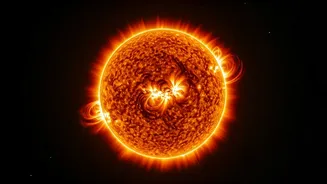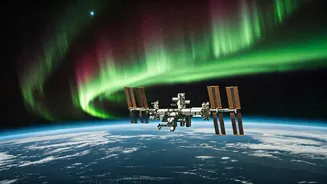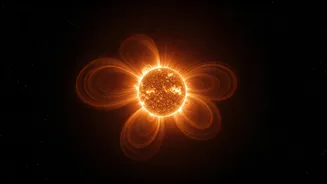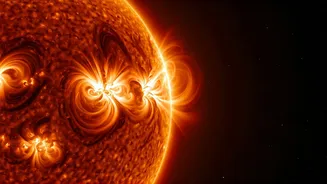Sun's Energetic Bursts
Solar storms are energetic events originating from the sun. They can involve solar flares, which are sudden bursts of energy, and coronal mass ejections
(CMEs), which are massive expulsions of plasma and magnetic field from the sun's corona. The most intense solar flares can cause global radio blackouts, while CMEs can trigger geomagnetic storms on Earth. These storms arise from complex processes within the sun's magnetic field, and their frequency and intensity vary over an approximately 11-year solar cycle. Scientists monitor solar activity to predict these events and assess their potential impacts on Earth's technologies and infrastructure. These forecasts allow for precautionary measures, mitigating the risks linked to solar storms.
Solar Storms and Impact
The effects of solar storms on Earth can be diverse and significant. Geomagnetic storms, caused by CMEs, can disrupt satellite operations, GPS navigation, and power grids. Intense storms have caused widespread blackouts in the past. Additionally, solar flares and CMEs can increase radiation levels in space, posing a threat to astronauts and the passengers on high-altitude flights. Auroras, or the Northern and Southern Lights, are a beautiful manifestation of solar activity, but they are also a visual indication of the energy entering our atmosphere. Regular monitoring of solar activity and its potential impacts is essential for mitigating the risks associated with these events.
Protecting Technology & Us
Preparing for solar storms involves both individual actions and coordinated efforts at the societal level. Government agencies and space weather forecasting centers continuously monitor solar activity and issue warnings when a major event is imminent. These warnings allow satellite operators and power grid managers to take protective measures, such as adjusting satellite orientations or reducing power grid loads. Individuals can also take steps to prepare, like ensuring their emergency kits include a radio to stay informed during outages. Further, shielding from radiation is crucial for astronauts and for those in high-altitude flights during intense solar events. Awareness and proactive strategies significantly reduce the risks associated with these solar phenomena.
Future Research & Safety
Scientists continue to research solar storms to improve forecasting and understand the underlying mechanisms. The study of solar flares, the analysis of coronal mass ejections, and the modeling of their impacts on Earth are ongoing. Advanced tools and techniques, such as improved space weather models and better observational methods, are constantly being developed. This research enhances our ability to predict solar storms and assess their potential effects on our technologies and infrastructure. International collaborations and data sharing are crucial to ensure that scientists worldwide have access to the information and tools necessary for this critical work. Continuous advancements in the understanding of solar activity will refine our protective measures, helping us to be ready for these energetic events.













